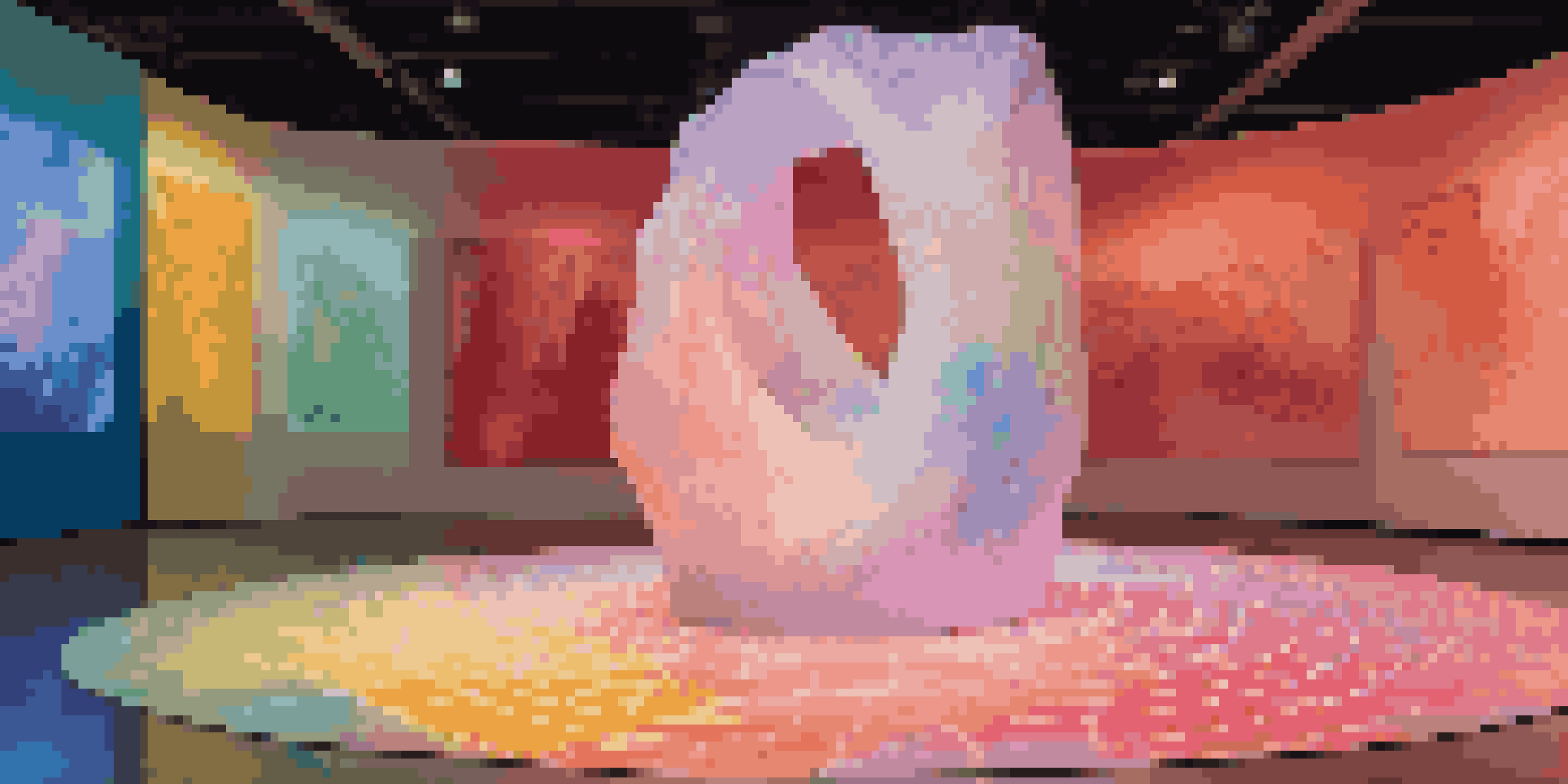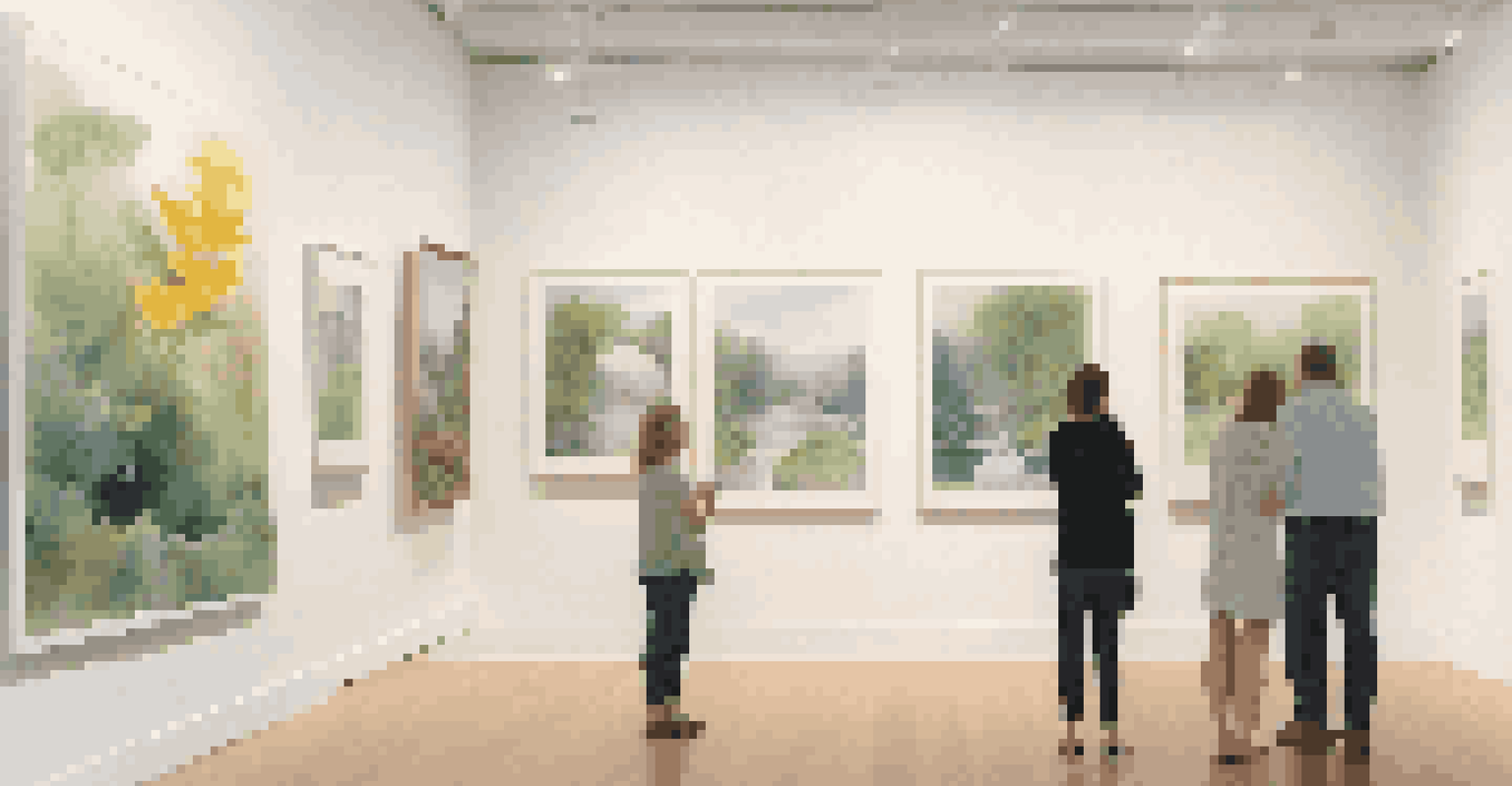The Role of Imagination in Multisensory Art

Understanding Multisensory Art: A New Frontier
Multisensory art combines various sensory experiences, including sight, sound, smell, and touch. This approach invites audiences to engage with art on multiple levels, creating a richer and more immersive experience. Think of it as a symphony where each sense contributes to an overall masterpiece, enhancing emotional responses and personal connections.
Art is not freedom from discipline, but disciplined freedom.
In this ever-evolving art form, imagination plays a pivotal role. It allows artists to envision how different senses can interact and influence one another, leading to innovative creations. For instance, an artist might imagine how the scent of lavender can evoke calmness while paired with soothing visuals and gentle sounds, crafting a unique sensory journey.
By leveraging imagination, artists can break traditional boundaries and explore new ways of expression. This freedom encourages experimentation and collaboration, resulting in art that resonates deeply with diverse audiences. Ultimately, multisensory art becomes a playground for creativity, inviting everyone to partake in the experience.
The Power of Imagination in Artistic Expression
Imagination is the driving force behind any artistic endeavor. It allows artists to transcend reality and explore ideas that may seem far-fetched or unconventional. For example, think of an artist who envisions a gallery where colors emit sounds, creating a harmonious blend that captivates visitors beyond traditional visual art.

When artists tap into their imagination, they can create immersive environments that transport viewers to different worlds. This engagement not only stimulates the senses but also provokes thought and emotion, making the experience memorable. Imagine walking into a room filled with vibrant colors, accompanied by the sounds of nature, making you feel as if you’re in a tranquil forest.
Multisensory Art Enhances Engagement
By combining various senses, multisensory art creates immersive experiences that invite active audience participation.
Furthermore, imagination fosters a sense of personal connection between the artist and the audience. By sharing their unique visions, artists invite viewers to interpret and engage with the artwork on a personal level. This interaction allows for a richer dialogue between the creator and the observer, blurring the lines between art and experience.
Sensory Interaction: Where Imagination Meets Reality
One of the most captivating aspects of multisensory art is its ability to create sensory interactions. These interactions occur when one sense influences another, enriching the overall experience. For instance, the taste of a particular food might evoke memories of a specific painting, illustrating how our senses are interconnected.
Imagination is the only weapon in the war against reality.
Imagination plays a crucial role in designing these interactions. Artists envision how different sensory elements can complement each other, crafting experiences that surprise and delight. Picture an installation where the sound of waves crashing is paired with the scent of the ocean, transporting visitors to a beach paradise.
By experimenting with sensory combinations, artists can push the boundaries of traditional art forms. This exploration not only enhances creativity but also encourages audiences to engage more deeply. The result is an art experience that lingers in the mind long after the encounter, emphasizing the importance of imagination in artistic expression.
Audience Engagement: Inviting Participation Through Imagination
In multisensory art, audience engagement is a vital component that transforms passive viewers into active participants. Artists often use their imagination to design interactive elements that invite the audience to touch, smell, or even taste aspects of their work. This invitation fosters a deeper connection with the art.
For example, an art installation might include textures for visitors to feel or scents to smell, encouraging them to explore the artwork with their senses. This participatory approach not only enhances the experience but also allows individuals to relate personally to the art. It's like entering a story where you play a role rather than just observing.
Imagination Fuels Artistic Innovation
Imagination drives artists to explore new techniques and technologies, leading to groundbreaking works that redefine art.
By weaving imagination into the fabric of audience engagement, artists create memorable experiences that resonate on a personal level. These interactions can spark curiosity and inspire viewers to return to the artwork, deepening their appreciation. Ultimately, this collaborative experience highlights the dynamic relationship between imagination, art, and audience.
The Emotional Resonance of Multisensory Art
Multisensory art has a unique ability to evoke strong emotions. By engaging multiple senses simultaneously, it creates a richer emotional landscape that can be profoundly impactful. For instance, a piece that combines uplifting music with bright visuals and comforting scents can evoke joy and nostalgia in viewers.
Imagination fuels this emotional connection by allowing artists to envision how different elements can elicit specific feelings. They can tailor their creations to resonate with audiences, tapping into universal emotions like love, sadness, or wonder. This personalized approach transforms the art into a powerful vessel for emotional expression.
When viewers experience this emotional resonance, it often leads to introspection and reflection. The art becomes a mirror that reflects their own experiences, memories, and feelings. Ultimately, the interplay of imagination and multisensory elements creates art that lingers in the heart and mind long after the experience is over.
Imagination as a Catalyst for Innovation in Art
The role of imagination in multisensory art serves as a catalyst for innovation. Artists are constantly pushing boundaries and exploring new techniques, materials, and technologies. By imagining how different elements can come together, they create groundbreaking works that challenge traditional notions of art.
For example, the integration of virtual reality (VR) into multisensory art allows artists to create immersive experiences that transport viewers to entirely new worlds. Imagine stepping into a VR installation where you can interact with the environment, feeling the textures and hearing the sounds as if you were truly there. This innovative approach exemplifies how imagination drives artistic evolution.
Emotional Connections Through Art
Multisensory art evokes strong emotions by intertwining sensory experiences, allowing viewers to reflect on their personal feelings.
Moreover, as artists experiment with new technologies, they often inspire others to think outside the box. This ripple effect fosters a vibrant artistic community that thrives on creativity and collaboration. Imagination becomes the common thread that connects diverse artists, encouraging them to share ideas and push the boundaries of what art can be.
The Future of Multisensory Art: Imagination at the Core
As we look towards the future of multisensory art, imagination will undoubtedly remain at its core. The potential for new technologies and methods will continue to expand, offering artists endless possibilities for exploration. Imagine a future where artificial intelligence assists artists in creating multisensory experiences, blending human creativity with machine learning.
This evolution will likely lead to even more immersive and interactive art forms, captivating audiences in ways we've yet to experience. Artists will be able to push the boundaries further, creating environments that engage all senses and evoke profound emotional responses. The future of art will be a dynamic fusion of imagination and innovation.

Ultimately, the role of imagination in multisensory art is crucial for its growth and evolution. As artists continue to envision new possibilities, they will redefine the way we experience art, inviting us to engage with it on deeper levels. This journey of exploration promises to be exciting, inspiring, and full of wonder.